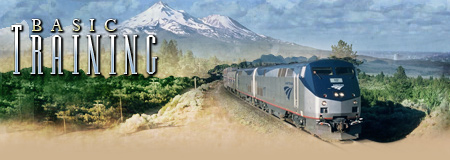
How to Travel by Train Successfully
by Jim Loomis
When we head off for that long-awaited and much-deserved vacation, most of us choose to travel to our get-away destination by plane or, if it's close enough, car.
Here’s a suggestion: The next time you’re planning a vacation, think about taking a train. If that conjures up the mental image of a crowded commuter train, think again. An Amtrak long-distance train is an iron horse of another color, with sleeping cars and coaches, a dining car and a lounge car, all serving the needs of 200 to 300 passengers. Interested? Here are some tips that’ll help keep your trip on the right track.
The first rule of train travel. Relax! A long-distance train is much more than just another mode of transportation; think of it as an important part of your vacation experience.
Sleeping car vs. coach. Train travel is inexpensive if you travel in coach class, but be aware you’ll sleep sitting up and share space with about 70 other people. If that doesn’t appeal to you, consider sleeping car accommodations. You’ll have privacy by day and a real bed to sleep in at night.
The roomettes are very compact, but quite efficient. There are several airline-type bathrooms in each sleeping car for roomette passengers. Bedrooms are quite a bit larger, and each includes a washbasin and a lavatory. Roomette and bedroom passengers have access to a shower room on the lower level of each sleeping car.
Sleeping car accommodations cost more, but to soften the blow, all dining car meals are included in the price of the ticket. For the two-night Chicago-Seattle trip, that could be worth about $150 for two people.
Pack smart. You’ll be much more comfortable in your cozy room if you leave your suitcases in the storage area near the entry doors of the sleeping car. Take only a tote bag to your compartment containing just what you’ll need for the night: toiletries, a change of underwear, a clean shirt, etc.
Making connections. If your itinerary involves making a connection–that is, getting off one train and onto another–beware! Because Amtrak’s long-distance trains operate on tracks owned and controlled by the freight railroads, they often are delayed because of freight traffic. It’s not uncommon for trains to run many hours late; missed connections are the inevitable result and potentially a huge headache.
Enjoy the dining car. Eating in a rolling restaurant is what passengers remember most about their train trips. During the Golden Age of train travel from the mid-1930s to mid-1950s, competing railroads would vigorously promote the quality of the food served on board. Today, Amtrak’s dining experience is less than gourmet, but perfectly fine. On a recent cross-country trip, the dinner menu included beef bourguignon, pork shanks, seared salmon and roast chicken. You even can order a split of acceptable wine, usually a choice between two reds or two whites.
Amtrak dining cars have community seating, meaning you’ll find yourself at a table for four, seated with two or three strangers. By all means, take this opportunity to get to know some of your fellow passengers. It’s an unexpected bonus to the experience.
Is train travel for you? Truthfully, it isn’t for everyone. Some people are too impatient. Others find the accommodations too confining. But for me, President Harry Truman said it best: “You get a real feeling of this country and the people in it when you’re on a train.” In my opinion, there’s no better option than relaxing, eating and sleeping in a tidy little hotel while America passes by outside my window. Give Amtrak a try and see if you don’t agree.
All Aboard!
Plan ahead. If you want to travel during the busiest times of the year–roughly May through October—make reservations as far in advance as possible. Sleeping car accommodations, in particular, can and do sell out several months in advance.
Fare tips. Your travel dates can make a big difference in the price of your ticket. Consider, for example, the two-night trip from Chicago to Seattle on the Empire Builder. In March, you’ll pay $268 for two seats in coach class. Upgrading to a roomette would increase the cost to $458, and the price of a bedroom would be $687. In July, those rates increase dramatically: Basic rail fare, $348; roomette, $707; bedroom, $1,163. Adjusting your schedule by a few days could save you money.
How to book. You can contact Amtrak directly at (800) USA-RAIL or online at www.amtrak.com. If you feel the need for personal advice, think about working with a travel agent, but be sure he or she really does know the ins and outs of train travel (many do not). There are quite a few agencies that specialize in rail travel, including Accent on Travel USA in Klamath Falls, Oregon. Their toll-free number is (800) 347-0645.
To find out which trips qualify as Jim's fave American train getaways, click here. |